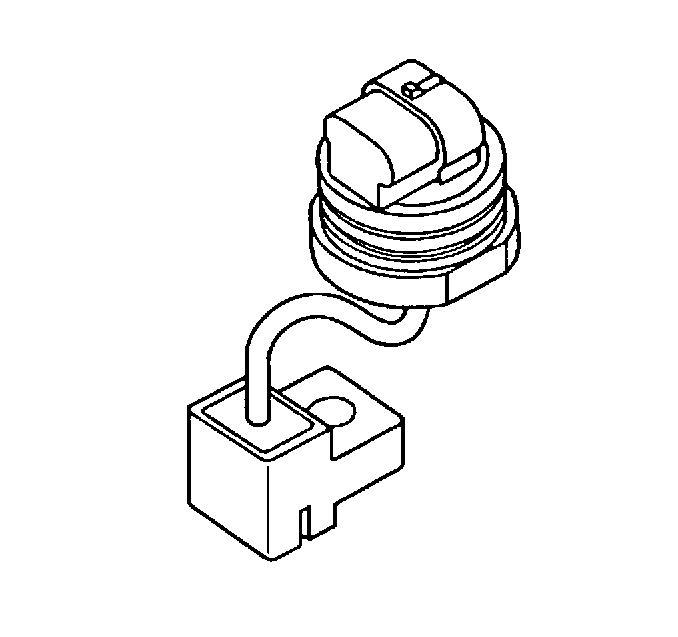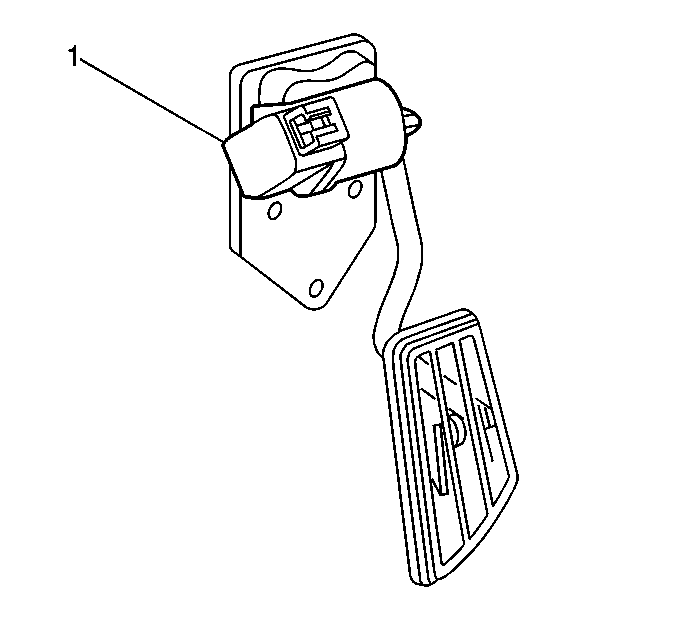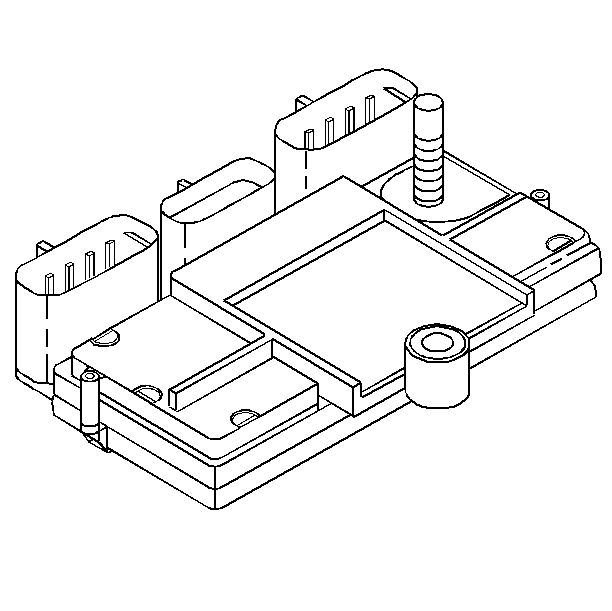Engine Coolant Temperature (ECT) Sensor
The Engine Coolant Temperature (ECT) sensor is used as an input to the PCM and the Engine Temperature gage located in the dash. A engine coolant temperature value is sent to the IP via a class II message from the PCM. The Engine Coolant Temperature (ECT) sensor is a thermistor (a resistor which changes value based on temperature) mounted in the engine coolant stream.
The PCM supplies a 5 volt signal through the thermistor in the Engine Coolant Temperature (ECT) sensor and then the PCM and measures the voltage to determine temperature. The voltage will be high when the engine is cold, and low when the engine is hot. By measuring the voltage, the PCM knows the engine coolant temperature. Engine coolant temperature affects fuel control and the glow plug system.
Intake Air Temperature (IAT) Sensor
The Intake Air Temperature (IAT) sensor is a thermistor (a resistor which changes value based on temperature) mounted in the intake manifold.
The PCM supplies a 5 volt signal through a resistor in the sensor and the PCM then measures the voltage. The voltage will be high when the intake air is cold, and low when the air is hot. By measuring the voltage, the control module knows the intake air temperature.
The PCM uses the IAT signal to control fuel.
Optical/Fuel Temperature Sensor

The optical sensor has a 5V reference that powers the optics. The PCM supplies a voltage (3.75 volts) to the optical sensor through the High Res signal circuit and Pump CAM signal circuit. The optical sensor then generates a High Resolution Signal and a Pump Cam signal and sends these signals back to the PCM.
Accelerator Pedal Position (APP) Module

The APP module contains three potentiometers (a device for measuring an unknown voltage or potential difference by comparison to a standard voltage). Each of the APP sensors send a varying voltage to the PCM. By monitoring the output voltage from the Accelerator Pedal Position (APP) module, the PCM can determine fuel delivery based on the accelerator pedal position (driver demand).
High Resolution Signal (256X)
The high resolution signal is an optical device which generates 64 equally spaced pulses per cylinder combustion stroke from the slotted disc mounted on the injection pump timing cam ring. The pulses are counted by the PCM and used to measure the angular pump displacement. Fuel is metered by using the angular indication and timing is measured by counting the angular pulses between the pump cam signal and the crankshaft position sensor signal.
Injection Pump Cam Signal (4X)
The Pump Cam signal is an optical device which generates one pulse per cylinder combustion stroke from a slotted disc mounted on the injection pump timing cam ring. The pulse is used to located the start of injection event for each cylinder (i.e. timing) with the respect to the crankshaft position sensor. The number one cylinder is identified with a wider pulse (larger slot in disc). The PCM uses this information to adjust idle fuel, timing, trigger real time events and is used in the diagnostics of crankshaft position sensor and the high resolution circuit.
Fuel Temperature Sensor

The fuel temperature sensor is a thermistor (a resistor which changes value based on temperature) mounted in the injection pump.
The fuel temperature sensor is part of the optical/fuel temperature sensor. The resulting voltage is monitored by the PCM which uses this signal to minimize fueling error due to injection pump efficiency changes due to very hot fuel.
The fuel temperature sensor receives 5V from the PCM through the Fuel Temperature signal circuit. The fuel temperature sensor has a thermistor (a resistor that changes based on temperature) that causes a voltage drop across the circuit. The PCM then interprets the amount of voltage on the circuit to determine fuel temperature.
Crankshaft Position (CKP) Sensor (4X)
The crankshaft position sensor is a hall effect type of a device which generates one pulse per cylinder combustion stroke from a four tooth reluctor wheel attached to the engine crankshaft. The pulse is used to locate the cylinder reference event (top dead center) for each cylinder. The PCM uses this information to adjust timing, trigger real time events and is used in the injection pump cam signal diagnostic.
Boost (BARO) Sensor
The boost sensor measures the changes in the intake manifold pressure. The boost sensor converts engine load and speed changes, then converts the change in readings to voltage output.
The PCM sends a 5 volt reference signal to the boost sensor. As the manifold pressure changes, the electrical resistance of the boost sensor also changes. By monitoring the sensor output voltage, the PCM detects the boost pressure. A high pressure (high voltage) requires more fuel. A lower pressure (low voltage) required less fuel. The control module uses the boost pressure signal to control fuel delivery.
The Boost sensor also is used for BARO readings only on vehicle not equipped with EGR. This sensor reads barometric pressure (BARO) under certain conditions, which allows the PCM to automatically adjust for different altitudes.
Vehicle Speed Sensor (VSS)
The VSS is attached to the output shaft housing. This device contains a permanent magnet surrounded by a coil of wire producing a magnetic field which is interrupted by rotor teeth pressed on an output shaft. As the rotor interrupts the magnetic field an AC voltage is generated in the circuit.
Fuel Solenoid Driver
The fuel injector driver receives an inject command signal from the PCM and provides a current regulated output to the fuel solenoid that controls injection. It also returns an fuel solenoid closure time signal back to the PCM to inform it when the fuel solenoid has actually seated.
Brake Switch
The TCC normally closed brake switch supplies a B+ signal into the PCM. The signal voltage is opened when the brakes are applied.
The cruise control normally open brake switch supplies a B+ signal to the PCM when the brake is applied. These signals are used by the PCM to control transmission and cruise control functions. The brake switches are part of the stoplamp switch.
Glow Plug System
There are two types a glow plug systems available, Federal and California.
The glow plug system is used to assist in providing the heat required to begin combustion during engine starting at cold ambient temperatures.
The glow plug relay switches power to the glow plugs and is commanded on and off by the PCM. The glow plugs are heated before and during cranking, as well as initial engine operation. The PCM monitors the glow plug relay output voltage which indicates if the relay is following the PCM commands.
California Glow Plug System

The California glow plug system has 8 individual circuits for each glow plug. Internally there is a driver for each individual glow plug circuit. The driver detects open and shorts. The California system has the ability to set a DTC for a glow plug/driver circuit failure or a relay failure. The glow plug relay is located in the same location as the federal relay. There is one battery feed circuit that feeds all of the driver pins (glow plug circuit). The California glow plug system is commanded by the PCM. A scan tool parameter located in a Engine Data List will correctly identify system.
Federal Glow Plug System
The federal glow plug system can not identify a glow plug failure. A scan tool parameter located in a Engine Data List will correctly identify system. The federal glow plug system is commanded by the PCM. A glow plug system must be performed to identify a glow plug failure.
Cruise Control System
The cruise control switches are part of the multifunction turn signal lever. These switches enable the driver to control the cruise on/off, set/coast and resume/accel signals. These signals are inputs to the fuel control portion of the PCM and allow the PCM to maintain a desired vehicle speed under normal driving conditions.
A/C Signal
This signal indicated that the A/C compressor clutch is engaged. The PCM uses this signal to adjust the idle speed.
